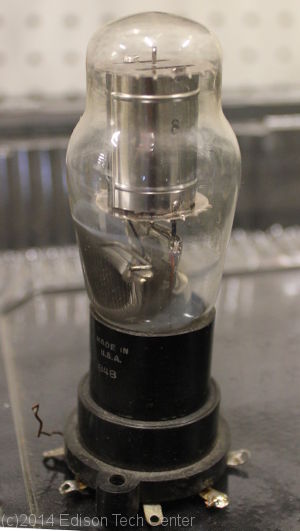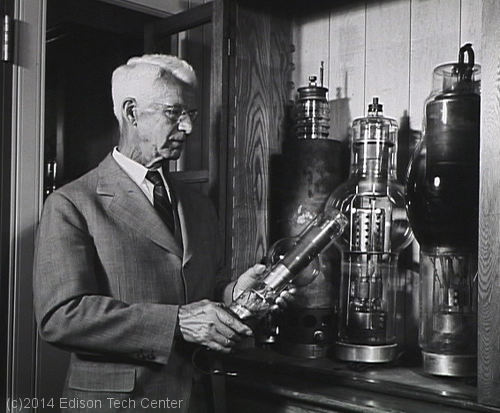Vacuum Tubes (Valves)
|
The vacuum tube (known as a 'valve' in the UK) is an interesting component
that made many important technologies possible and it is still used in many things.
There are many
kinds of vacuum tubes for different jobs. Most types of vacuum tubes have
been replaced by semiconductor devices, however vacuum tubes will occupy
an important role in the future in the field of nanotechnology. All 'tubes' basically consist of an anode and cathode in a gas or vacuum environment. They range in appearance from tiny ceramic parts the size of a corn kernel, to 1+ meter tall solid steel klystron tubes used in broadcast television or radar installations. Most tubes you can find around your house or garage in old electronics will be glass or aluminum, cylindrical, and between 1-6" tall. 1.) Crossing Barriers (The Edison Effect):Thermionic emission is the concept behind most tubes. A filament heats up in the vacuum and when it reaches the right temperature electrons are emitted and cross over onto a positively charged plate. More on thermionic emission (wiki) > So how is this useful? You can create a diode with this concept. A diode allows current to flow only in one direction. This can be used in devices to convert AC to DC power, convert voltages, or to construct a logic gate (which can do the job of acting like a relay or computer). The first vacuum tube diode was made in 1904. Other kinds of tubes like triodes can be used as amplifiers and enabled the development of the oscillator. Oscillators are used to filter and amplify signals, this is very important in radios, clocks, computers, television transmission, microwave/radar transmission and countless other things. In the field of radio/tv triode tubes replaced alternators as they could produce high frequency signals without the cumbersome mechanical apparatus. Tubes were used in TV cameras and made the first video images. There are countless types of specialized tubes, some of which are still used today. |
Sections: |
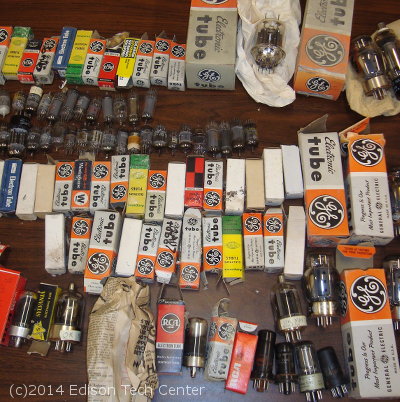 |
Tubes have heaters and filaments that would normally burn out like light bulbs. The ENIAC computer had more than 17,000 tubes and one would burn out every two days. Consumers expected to replace tubes in their radios, TVs and other appliances. This is why radios and TV tubes had an easy to understand 'plug-in' design. Unique pin configurations prevented you from plugging in the wrong tube. |
Thyratron
Thyratrons improved power systems, they could handle high voltages and act as a switch or rectifier. They could be used as a radio detector (in radar for example) and to convert AC to DC power. After 50 years they were replaced by thyristors (solid state).
Triodes:
Triodes are tubes which can be used in amplifiers, computers, radio receivers and transmitters and other things. Triodes were later replaced by transistors. This tube has a hot cathode in the center surrounded by a metal grid with the anode surrounding that. The cathode emitts electrons, and in the vacuum electrons freely flow through the grid to the anode. By energizing the grid negatively you repel more electrons, this means that less electrons can pass through the grid to get to the anode.
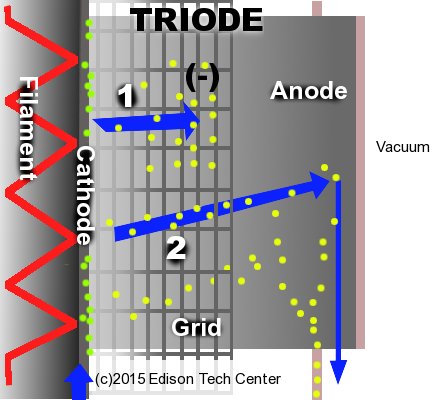 |
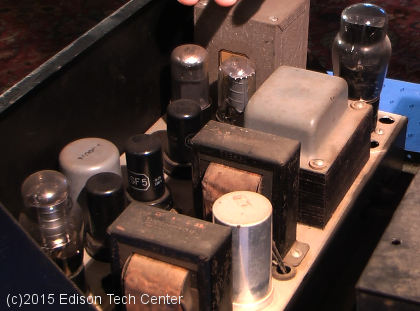 |
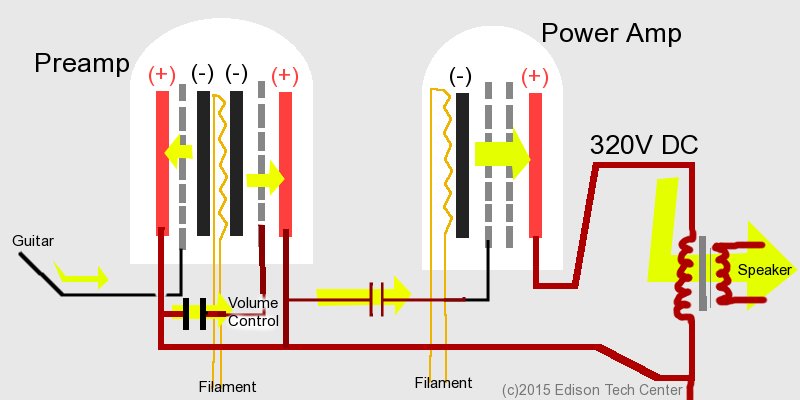
Klystrons:
Klystrons were used in television, cold-war radar systems and radio transmission for many years, see our video with Rudy Dehn and colleagues at General Electric to learn about how they work.
Below: Video on how a klystron tube works
3.) Brief Timeline: History
1880 - Thomas Edison discovered thermionic emission when experimenting with lightbulbs, he found electrons left the carbon filament and were attracted to a metal plate placed in a bulb with a vacuum.
1904 -Diode vacuum tube invented by John Ambrose Flemming, based on Edison's discoveries.
1910s - Irving Langmuir develops the first 'high vacuum' tubes using the newly discovered ductile tungsten. He worked with G.S. Meikle on the first Thyratrons at the GE Research Lab
1921 - Tubes made the first audio amplifiers work, so that the first loudspeaker could be developed.
Video - tubes used in the first loudspeaker >
1927 - Tubes make television possible, they are used in cameras, radio transmission and in the CRT television for display of the image.
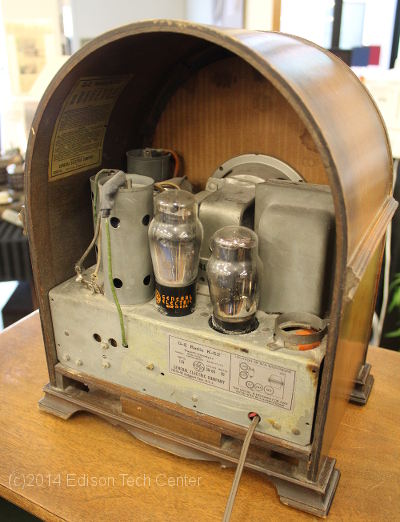
Tubes in a radio on display at the Edison Tech Center |
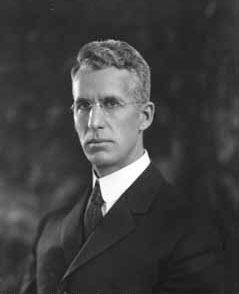 |
 |
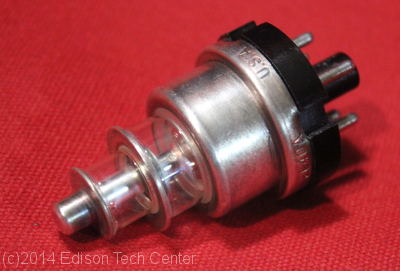
|
|
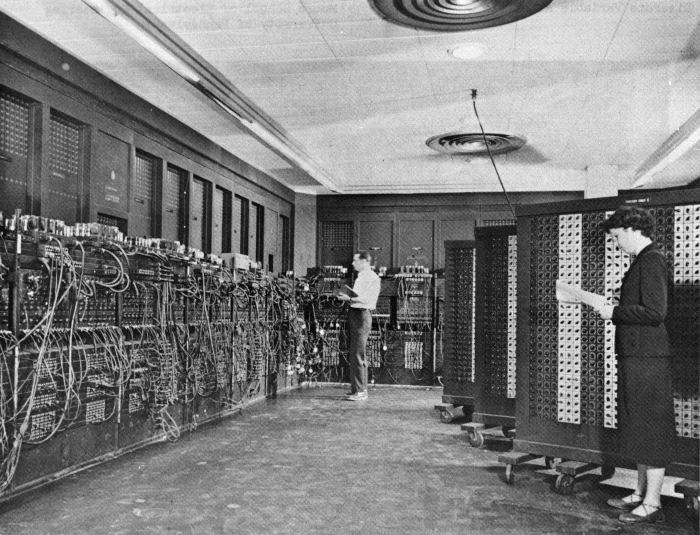
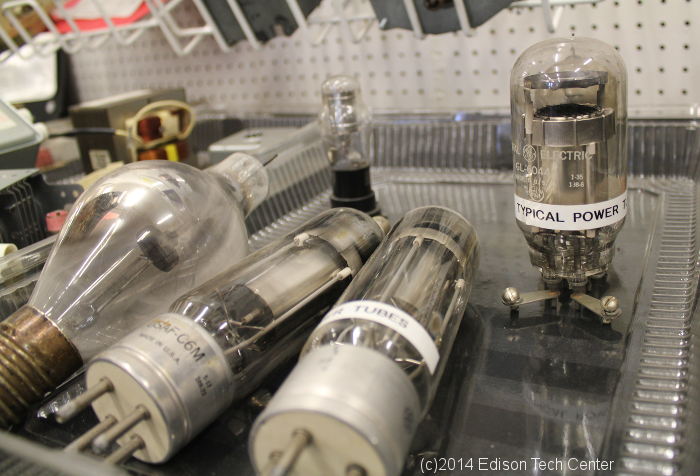

Above: In the 1950s General Electric management was excited when they started producing high quality vacuum tubes which were a fraction of the size of past tubes. By this time solid state was beginning to make many tubes obsolete and the new revolution in tubes never reached fruition.
1950s-60s - Most vacuum tubes were replaced by transistors in the west.
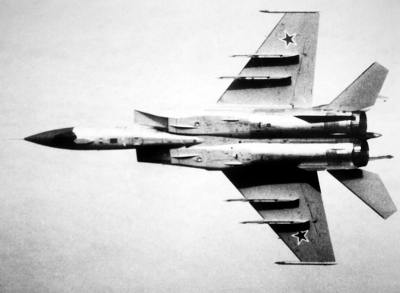
|
|
In the 70s and 80s tubes saw continued use in amplifiers and oscillators as they were more reliable at high power levels.

Above: what was an extremely expensive vacuum tube used in a professional video camera of the 1970s. There used to be one tube for each color with a prism to separate the red, green and blue. These tubes were replaced by charge-coupled devices (CCDs).
1990s-Today - Vacuum tubes are still used today. Musicians still use tube amplifiers and claim they produce a different and desirable sound compared to solid state amplifiers. See the video below showing the tube's use in a guitar amplifier:
Below: Corbin Irvin at the Edison Tech Center showing tubes in a typical audio amplifier.
4.) Future: The Nano Vacuum Tube
Vacuum tubes may make a comeback and replace standard microchips. Engineers have been able to build a structure in phosphorus doped silicon and use nanotubes to build a switch. These devices can operate 10 times faster than silicon transistors.
Nano Vacuum Tube Articles:
Extreme
Tech article >
Science Magazine article >
Let's see what the future brings!
Computer Related Topics:
The
first RAM
Early Computers at GE
Amplifiers
Hard Disk Drives
Computers
Capacitors
Computer Memory
Related Topics:
|
Semiconductor Electronics |
Microwave Ovens & Magnetrons |
Television |
Amplifiers |
Radio |
More Stuff |
Article by M.Whelan and W.Kornrumpf
Sources:
General Electric
AllaboutCircuits.com
Wikipedia
Semiconductors. Edison Tech Center. 2013
Diodes. Sparkfun
Return of the Vacuum Tube. Science AAAS. 2012
MiG-25 Foxbat. GolbalAircraft.org
John D. Harnden Jr. - former General Electric Engineer
Photos:
Edison Tech Center
General Electric


